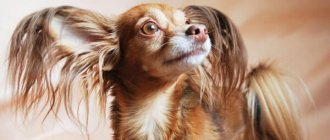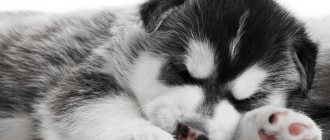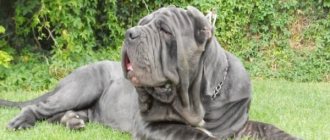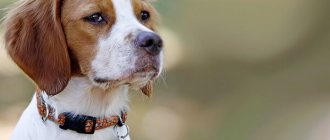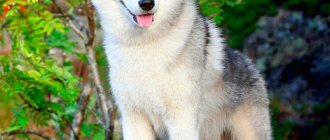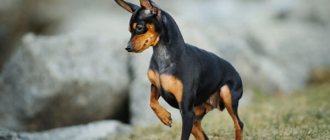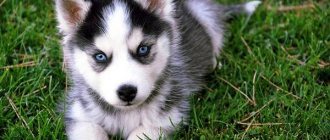The homeland of Siberian huskies is the northeastern part of Siberia.
In these parts there are quite difficult conditions for survival and people were forced to look for not just a companion, but a reliable friend and helper.
This is how the husky appeared. It is believed that the ancestors of this breed were wolves and northern wild dogs.
The dog's height is 50-60 cm, weight is 18-28 kg, life expectancy is 12-15 years.
What does an adult husky look like?
The Siberian Husky is one of the most beautiful and unpretentious dog breeds. The dog is distinguished by its ease of gait, speed and unusual almond-shaped eyes.
As for the body, it can be called moderately compact and quite strong. The dog has a medium-sized head, a strong loin and a slightly sloping croup. Adult huskies have powerful and strong paws, as well as developed muscles, which allows the dog to move quickly and gracefully.
In general, the dog makes a rather harmonious impression, due to the fact that the limbs, head, muzzle and neck have a proportionally correct relationship. The tail of Siberians is fluffy, slightly similar to a fox’s, in an excited state it is raised up, in a calm state it is lowered. The ears are erect, high-set, triangular in shape.
It’s worth mentioning separately about the pet’s eyes; they can be blue or brown in color; heterochromic eyes (different colors) are also allowed by the breed standard. Moreover, their shape in this breed is almond-shaped, and their location is slightly slanting.
The coat of such pets is of medium length, very thick, soft with a dense undercoat. The color palette can vary from snow-white to black.
NOTE!
The husky's calling card is a special mask on its face, which has a unique pattern that is unusual for representatives of other breeds.
How to toilet train
Until the end of the quarantine period after vaccination, the puppy cannot be taken outside, so at first it is necessary to teach him to relieve himself in the house, in a specially designated place.
To do this, you need to limit the pet’s space by allocating him 1 room or part of it, covering the entire floor in it with newspapers or diapers - this will not allow the puppy to go to the toilet by.
Every time your husky relieves itself in its diaper, you need to praise and encourage it. Gradually, the number of diapers should be reduced until only 1 remains, which can eventually be replaced with a tray.
If for some reason it is impossible to limit the dog's space, you should place as many diapers as possible throughout the house, especially near doors and windows.
Often the dog itself chooses a place for the toilet, in which case a diaper should also be placed there, even if it is the center of the room.
NOTE!
After eating, sleeping and active play, the puppy should be taken to the toilet and not allowed to leave until he relieves himself. After this, the dog must be praised and treated with a treat.
When your husky is 6 months old, you can begin to train him to use the toilet outside . To do this, you need to take the dog out for a walk every 40-60 minutes. after feeding and wait until she goes to the toilet.
It may happen that the puppy, out of habit, waits until he gets home to go to the litter box, then in the future you need to take a newspaper or diaper soaked in urine with you and increase the time of walks.
Breed standard
According to international breed standards, purebred huskies must meet the following requirements:
- The dog's head should be proportional to the body, the muzzle should be of medium width, and the lips should be thin (not loose).
- The eyes of this breed are almond-shaped, set slightly slanted and moderately wide. According to the standard, heterochropromia of the eyes (different colors of the irises) is allowed.
- The pet's ears are medium-sized, triangular and high-set.
- The chest is powerful, but not too wide.
- The neck is curved and raised.
- Paws (front and rear) are straight, parallel, slightly spaced apart.
- The tail is bushy, set just below the top line of the back, in an excited state it is curled up in the shape of a sickle, and in a resting state it is dropped down.
- This pet's coat is short, but very thick, and the undercoat is dense and soft.
How to stop biting?
Representatives of this breed are not characterized by aggressive behavior.
If a puppy under the age of 4 months bites the owner and other family members on the arms or legs, this is normal . Most likely, this is how the little husky shows his emotions and encourages him to play with him.
However, this behavior should not be encouraged, otherwise the pet will decide that this can always be done.
It is important from an early age to show the husky who is the leader in the house, to let him understand that he is not the leader of the pack . For any manifestation of aggressive behavior and attempts to bite someone, it is necessary to demonstrate your strength to the puppy, while avoiding physical punishment.
It is enough to pull the dog by the collar so that its muzzle is pressed to the floor, and hold the animal in this position for several seconds.
After this, defiantly ignore the pet for another 2-3 minutes, emphasizing your dissatisfaction with its behavior..
Character traits
Siberian Huskies are considered quite intelligent and sociable animals, they are especially attached to children, they are excellent nannies and friends of children.
Some even believe that such a dog does not need special training; simple interest is enough for him.
At the same time, huskies are so friendly that they calmly accept even completely strangers and animals. But at the same time, they can be wayward and stubborn; they simply need a strong leader.
In addition, the dog requires daily physical activity, as its activity is simply off the charts.
IMPORTANT!
The Siberian Husky is a breed that will never become a watchman or guard, due to its natural friendliness. At the same time, violent induction of aggression can lead to mental disorders.
How to feed correctly and how often
Proper feeding is the key to healthy development of a puppy. It is important that the diet is balanced and includes all the necessary vitamins, nutrients, macro- and microelements.
The number of daily feedings depends on the age of the dog:
- up to 8 weeks – 6 times;
- 2-3 months – 5 times;
- 4-6 months – 4 times;
- 6-10 months – 3 times;
- from 1 year and older – 2 times.
Improper nutrition, especially during the period of active growth of the puppy, can lead to the development of pathologies.
Weekly menu for a puppy 4-5 months old
| Day of the week | Menu |
| Monday | Beef, rice porridge, vegetable oil, sour cottage cheese, stewed vegetables, egg, kefir, grated apple |
| Tuesday | Rabbit meat, buckwheat porridge, vegetable oil, calcined cottage cheese, stewed vegetables, kefir, apple |
| Wednesday | Turkey, rice porridge, vegetable oil, cottage cheese, stewed vegetables, egg, yogurt, apple |
| Thursday | Salmon, buckwheat porridge, vegetable oil, sour cottage cheese, stewed vegetables, yogurt, apple |
| Friday | Pink salmon, rice porridge, vegetable oil, calcined cottage cheese, stewed vegetables, kefir, apple |
| Saturday | Beef, rice porridge, vegetable oil, calcined cottage cheese, stewed vegetables, egg, kefir, apple |
| Sunday | Turkey, buckwheat porridge, vegetable oil, sour cottage cheese, stewed vegetables, yogurt, grated apple |
Portions should be measured according to the activity level and health of the individual..
Breeds that are often confused with Husky
The breeds most often called husky varieties are:
- Sakhalin Laika.
- Klee-kai.
- Malamute et al.
In fact, these are amateur breeds with their own history and standards.
Sakhalin Laikas
Sakhalin huskies are a very rare and ancient breed of dog. Their homeland is Sakhalin Island. These are dogs with a very powerful and large body, an elongated body and a strong skeletal system.
As for the differences between the Sakhalin husky and the husky, they are very significant. Firstly, this is the exterior. Secondly, huskies are more suitable for hunting, while huskies are more suitable for sledding. In addition, Sakhalin huskies can bark from time to time like an ordinary dog, but huskies practically do not do this to express emotions; they howl like wolves.
Klee Kai
Other names for this breed are mini-husky or toy husky, its homeland is the USA, the time of appearance of the breed is the 1970s.
Klee Kai are small, playful and very beautiful dogs, similar in appearance to huskies, but smaller in size. The height of such a pet is 33-35 cm, weight -7-8 kg, but there are also smaller varieties. This dog is very friendly, so it is most often kept in an apartment as a pet or a companion for children.
Alaskan Malamute
The Alaskan Malamute's closest relatives are the German Shepherd, Northern Husky and Border Collie. Outwardly, such a dog is a cross between a Siberian husky and a husky.
The coat of such a dog is short, but thick and dense; the hair is almond-shaped and has a blue or brown tint. Life expectancy is 12 -15 years.
By nature, Malamutes are loyal, gentle and affectionate; they are especially kind to children and play with them with pleasure. In addition, dogs are very active, mobile and require long walks and active games.
What to feed your husky
Small puppies are fed little, but often - up to six times a day, gradually reducing the amount by half during the first year. It is enough to feed adult and fully formed animals once or twice.
We recommend using specialized food specifically for huskies or a series for active, active dogs. There is no need for vitamins with a proper diet, so let your veterinarian prescribe them.
Photo: dogisworld.com
Organizing natural feeding for huskies is quite difficult, because they need a lot of meat. Moreover, raw or immersed in boiling water for a maximum of a second. Don't give your dog chicken because huskies are often allergic to it.
Eliminate pork and lamb and feed your pet beef, rabbit and turkey. You can give cereals and vegetables, except potatoes and legumes. We recommend fermented milk products instead of milk, and the yolk instead of a whole egg. Add fish oil and some vegetable oils to your diet.
Photo: pinterest.ru
Photos and descriptions of colors
This breed has a wide variety of colors, with some colors considered basic, while others are rare. Some colors are found only in working or riding lines of the breed and are not found in show representatives.
The most common types of colors:
- Black . In its pure form it is very rare and can be interspersed with small light areas of fur on the paws, tip of the tail and muzzle. However, for a pet to be considered black, at least 75% of its body must be black.
- Absolutely white is also considered a very rare color. It is characterized by a completely white coat and the same undercoat. The color of the nose can be black, brown or flesh-colored.
- Black and white . In this case, the percentage of colors will be 50/50. From above, the dog is torn by a solid black stripe, covering the back, the top of the head and part of the tail. There is a white stripe below, while the paws are always white and have reddish areas on the folds.
- Silver color allows the presence of only gray colors, while all warm shades are absent here. The color of the undercoat can vary from white to silver.
- Grey . With this color, the coat color will be black, and the undercoat color will be silver with beige shades.
- Copper or chocolate color . It is characterized by rich copper and dark red colors of the coat and undercoat, and the presence of white and cream colors is also acceptable.
What color should a husky's eyes be?
The husky standard allows both blue or brownish eyes and heterochromia, in which one eye of the animal is dark and the other is blue or bluish.
In general, Siberian Huskies have the following eye colors:
- Blue.
- Brown.
- Amber.
- Olive.
In addition, the blue color of the iris most often occurs in dogs that have a gray-white and white-black (black and white) color , and much less often in those individuals who have a pure white, brown or reddish coat.
IMPORTANT!
If the color is dominated by warm coat colors, such as chocolate or various red shades, then the husky’s eyes are most likely to be brown or heterochromic.
Smooth-haired and long-haired
If we talk about the smooth-haired husky, then its coat can be called double, well-haired, thick, but not long. It does not hide the dog's silhouette, has a soft, dense undercoat and straight guard hair.
During the molting period, the undercoat may be absent and this is the norm. A long, coarse or shaggy coat is a fault and will result in a lower score in the show.
As for long-haired huskies, their hair is slightly longer than that of smooth-haired representatives of the breed. At the same time, it is not inferior in softness and thickness. Along the back line of such pets there is a stripe of longer hair than on other parts of the body. As for the colors, they fully correspond to this breed, as does the physique.
NOTE!
According to international standards, heavily fluffy huskies are considered not purebred and are not allowed for exhibitions.
Origin story
Even in ancient times, sled dogs were bred in what is now the Far East. The active development of the direction in its modern form began in the seventeenth century, when the need for transport increased. New, roomy sleighs and sleds appeared, and even more dogs were needed for them.
In 1908, Siberian dogs came to North America, because the Gold Rush in Alaska had just begun. In the USA, the breed was recognized even earlier than at the international level - in 1934. Even the specific names of the breeders who were at the origins of the formation of the standard are known - William Husak, Foke Maul Ramsey and Olaf Svenson.
The very concept of “husky” is a corruption of “Eski” or Eskimo. Now all representatives of the breed are divided into three groups - sledding, working and exhibition. They differ slightly in appearance, but basically it all depends on the opinion of a particular expert.
Photo: irobot-tbk.ru
Do these dogs need to be groomed?
According to experienced dog breeders, it is not advisable to cut your Husky's hair, with the exception of light hygienic trimming, in which the trimmed dog simply takes on a more well-groomed appearance - regrown hairs are removed between the toes, around the anus and genitals, as well as in the ear area. This treatment is done for hygienic purposes and should not affect the appearance of the dog.
Another reason why it is not recommended to cut huskies is a violation of heat exchange, because thick hair warms the dog in winter, and saves it from the heat in summer.
A properly trimmed Husky looks neat without altering its natural contours.
Siberian Husky - photo
Husky is not only a loyal friend, but also concentrated beauty. It is with great pleasure that we have compiled a large selection of photos for you!
Photo: nevseoboi.com.ua Photo: thegorbalsla.com
Photo: pet365.ru Photo: krasivosti.pro
Photo: drive2.ru Photo: drive2.ru
Photo: funart.pro
Photo: klkfavorit.ru
Photo: kutyata.rf
Photo: krasivosti.pro
Photo: krasivosti.pro
Photo: funart.pro Photo: krasivosti.pro
Photo: desktopbackground.org
Photo: husky.forum.ru
Photo: hdqwalls.com
Photo: krasivosti.pro Photo: mypets24.com
Photo: krasivosti.pro
Photo: youtube.com Photo: expertoanimal.com
Photo: fisher-fish.ru
Photo: uprostim.com
Photo: thehappypuppysite.com
Did you like the post? Subscribe to our channel in Yandex.Zen, it really helps us in our development!
Are boys different from girls?
Sexual dimorphism in this breed is quite pronounced - a male, as a rule, is more powerful, stronger and stronger than a girl. In addition, it always has a more elegant color and looks more impressive.
But it would be wrong to say that girls of this breed look pale and homely. At the same time, knots are always smaller in size and have a slightly lighter frame. However, they are not fragile and delicate, since such individuals were cut off by centuries-old selection in the north.
As for exhibitions, males usually make a stronger impression due to their representativeness and brightness of color.
Which dry food to choose
Budget food of economy class, such as, for example, Pedigree, Chappi, Darling, ARO, is not suitable for feeding huskies..
They contain artificial colors, flavors, preservatives, flavor enhancers and other additives that have a negative impact on the dog's health.
Also, such foods contain low-quality by-products, grains, and do not contain vitamins and minerals necessary for the growth and development of the pet.
Premium, super-premium and holistic foods are suitable for feeding representatives of this breed.
The most popular food brands are Nutra Gold, Advance, Purina Pro Plan (especially the Sensitive Salmon, Medium Robust Health, Medium Robust, Medium Puppy Sensitive, Royal Canin, Happy Dog lines (Maxi Baby and Nature Croq lines).
What do the puppies look like?
In the 1st month of life, husky puppies go through 2 most important periods of their lives.
The first 2 weeks are considered the neonatal period. At this time, babies are almost completely helpless and are dense lumps, unable to see, hear, empty themselves and warm themselves. The mother performs all these functions for them.
Starting from the 3rd week, puppies enter a transition period. At this time, their eyes are already open, hearing and interest in the world around them appear.
By the end of the first month, the baby already has milk teeth and begins to taste solid food. At the same time, the puppy continues to feed on mother's milk.
From the 2nd to the 3rd month of life, the dog actively gets acquainted with the world around him, he is curious, sociable and affectionate. This time is also considered a period of early training.
It is during this period that boys experience the descent of the testes into the scrotum. If this does not happen or only one testicle has descended, then you should consult a veterinarian. Often the reason for non-descent of the testes can be stress or emotional overload, since puppies are especially vulnerable at this age.
At the 3rd month of life, the puppy’s weight increases approximately 3 times, and the height at the withers increases by 2 times. At the same time, active growth of tubular bones, chest and skeleton continues. At the same age, puppies begin to establish a hierarchy and the owner’s task is to show the baby who is boss in the family. Also at this time, baby teeth begin to change to permanent ones.
At the 4th month of life, the baby’s growth and development stabilizes and gradually slows down; the puppy enters a period of independence. He also experiences the appearance of his first sexual instincts, which often manifests itself in jumping on fellow tribesmen or on the owner’s leg.
5-6 months – period of independence. The puppy can become very willful, which results in ignoring commands or defiant behavior. At the same time, the eruption of permanent teeth is completed, so the dog has a constant need to chew something. This age is the best period to attend obedience courses.
The age of 6-8 months is another growth spurt, as well as a period of strong fears. During this time, the dog may behave a little strangely, for example, it may be afraid to approach something or refuse to do something that it did before. Outwardly, at this age, the puppy becomes similar to an adult dog.
From 8 to 12 months, a husky is considered a sexually mature young dog. By this moment, all senses have already been formed and the puppy’s perception of the world around him is comparable to the perception of an adult dog.
Does eye color change over time?
Almost all Husky puppies have blue eyes once they mature around 21 days after birth.
But this does not mean at all that the blue-eyed puppy will remain so. The formation of the retina continues for up to two months, and in most puppies around this age it becomes clear whether the eyes will remain blue or darken.
The color of a husky's iris can change during the first 6 months of life, so only after reaching this age will it be possible to correctly determine the color of his eyes.
IMPORTANT!
If the blue eye color has changed to any other shade in an adult animal, then this is a reason for an immediate visit to the clinic, since a change in eye color in dogs is often associated with some serious disease.
How to choose your future pet?
Before deciding on a puppy, you need to do the following:
- Inspect several kennels, compare prices and conditions for keeping dogs.
- Examine the entire litter at the age of 1-1.5 months and compare the puppies. It is at this age that the dog’s character and temperament, as well as its behavioral skills, manifest themselves.
- Pay attention to the puppy's health condition. A healthy baby should be moderately well-fed, active, and well-groomed. In addition, he must have a good appetite and a healthy interest in the outside world.
- You must definitely ask the owner of the kennel to show the documents of the parents, as well as the puppies themselves.
You can pick up your baby at the age of 1.5-2 months; it is during this period that puppies are already quite independent and easily adapt to new conditions.
IMPORTANT!
Despite the fact that this breed is suitable for keeping in an apartment, it is not recommended to leave the dog alone at home for a long time. Otherwise, the pet may get bored and start acting up. In addition, loneliness makes the husky too independent and disobedient.
Husky care
There is a stereotype that huskies are very difficult to care for. But in fact, the main difficulty is only that the dog needs constant physical and mental stress. In other matters, residents of the far north are quite unpretentious.
Conditions of detention
Although huskies are now often kept in apartments, they are not made for four walls. A dog feels best outside the city when it has its own home and a large area. Otherwise, be prepared to walk the dog for hours and look for places where it can run around to its fullest.
Photo: pet-master.ru
Hygiene
Oddly enough, caring for huskies is quite simple - they don’t even need to be bathed. Moreover, an unpleasant odor often appears precisely because of water procedures that disrupt the natural balance. But be sure to comb the fur, brush the teeth and periodically examine the eyes and ears.
Photo: mocah.org
Walks
Huskies need intense exercise, otherwise they simply become destructive to everything around them. They need to run a lot and engage in active leisure activities. They willingly participate in sports, go hiking and overcome obstacle courses. It is strictly forbidden to leave an untrained husky in a new unfenced area alone and without a leash.
Photo: siberians.ru
Education and training
Huskies are not at all aggressive, so training does not cause problems in this regard. But they are smart, willful and independent - sometimes this causes difficulties when the dog must follow a standard algorithm. For the same reason, huskies are not used instead of service dogs, and it is recommended to train them in a playful way.
Photo: siberians.ru
Scottish Fold cats: description, character and care
Pros and cons of the breed
| + | – |
| Ideal working and sled dog | The rarity of some breeds and their high cost |
| A wonderful companion | Not suitable for apartment living |
| With proper upbringing, he gets along with cats. | Heavy seasonal shedding |
| Good with children | Requires professional training |
| Does not require careful care | May be stubborn and self-willed |
| Easily trainable | Requires a high level of physical activity |
| Suitable for active owners |
Huskies are hardy, freedom-loving dogs. They cannot be locked in an apartment and walked twice a day. Northerners need constant activity and will wither away from boredom and idleness. Huskies need a decisive, strong owner who will become his absolute authority. Keeping this breed is a big responsibility. The northerners will spin out of control as soon as they feel the weakness.
Education and training
Alaskan Klee Kais need socialization from the first days of life in a new home. This breed is not a timid one, therefore, in the absence of proper education, the dog has a tendency to show aggression and defend its territory.
This dog is destined for glory!
The best way to learn the rules of behavior in society is through play. Set tasks for your furry baby, praise them for their successful completion, or, conversely, let your pet understand that you don’t like the result. The main thing is not to flirt: this is fraught with loss of authority in the eyes of the animal, and it will be quite difficult to regain the title of leader.
The inquisitive mind of the Alaskan Klee Kai makes the training process as easy as it makes it difficult. The dog is smart and independent at the same time: it will happily learn a new command, but whether it wants to carry it out is a rhetorical question. You shouldn’t wishful thinking and expect that the Klee Kai will unquestioningly do everything you ask him to do: bring slippers or a newspaper, bark three times, or tragically “die” better than any Hollywood actor. Huskies, however, endowed their “descendants” with an impressive amount of stubbornness, so showing weakness risks the fact that the Alaskan Klee Kai will start training you on its own.
Representatives of the breed need knowledge, so do not forget to teach your pet new commands. Stick to a clear order, otherwise the Klee Kai won't remember anything. A similar result awaits you if you show aggression during the training process. A stern look and frowning eyebrows are enough: the Klee Kai can easily recognize your displeasure. Shouting and trying to raise your hand to your pet will not speed up the assimilation of the command and will only turn the dog against you.
It is recommended to alternate training with sporting events. The most popular options are still chasing a frisbee, an obstacle course and jogging next to a cyclist (bikejoring). Freestyle is also considered no less useful - repeating commands to the beat of lively music.
Teaching an Alaskan Klee Kai to a leash is another important point in training. It is worth teaching the dog to respond to its own name, otherwise it is strictly forbidden to let your pet off the leash! Representatives of the breed are known as escape artists, so you shouldn’t hide the leash in a drawer if you don’t want to lose your pet.
How many types of huskies are there?
Husky is a breed of dog that includes several subspecies, distinguished by their ability to live in harsh climatic conditions and run quickly in the snow. Hardy dogs with a good disposition are often harnessed to sleds and offered rides to tourists.
Among the most famous varieties:
- Siberian.
- Klee-kai.
- Baikal.
- Sakhalin.
- Kamchatka.
- Chinese.
- Yakut.
- Alaskan.
- Finnish.
How to train and what commands to teach?
The table below describes how to teach your husky puppy commands.
| Team | Education |
| To me | After the pet remembers the name and begins to associate itself with it, you need to call it by name, clearly saying “Come!” When your pet approaches, you need to praise him and give him a treat. |
| Near | During a walk, the dog should walk at the owner's left foot. In order for the pet to remember this, you need to say the command “Nearby”, pull the leash, holding it in the right place and not allowing it to move to the side or overtake the owner |
| Sit | Pull the leash up, forcing the husky to raise its head, then say the command and lightly press the dog on the rump so that it sits |
| Ugh | When the puppy does something prohibited, for example, tries to eat something on the street, you need to grab it by the withers, shake it and clearly say “Ugh.” |
Exhibition animals must also master the commands “Show your teeth” and “Give me your paw.”.
It would be a good idea for any dog to learn the commands “Place” and “Lie Down”, and if you plan to use a husky as a sled dog, then training for the commands “Forward”, “Right/Left” and “Stay” will be required.
Care and maintenance
Walking an Alaskan Klee Kai
Small-sized Alaskan Klee Kais are perfect for keeping both in a country house and in apartments. Proper feeding will relieve you of the characteristic “dog” smell - and this despite the long hair, which in most cases exudes an unpleasant “aroma”. The cleanliness of the dogs also adds to the karma of the breed: the Klee Kai always avoids foul-smelling garbage and does not feel the desire to roll out in it, which is what most of its relatives do.
Caring for your pet's coat will not be difficult, since these dogs spend the lion's share of their time maintaining the cleanliness of their own fur. Sometimes Alaskan Klee Kais are compared to cats for their unique ability to wash themselves with their front paws. Like felines, miniature huskies love to groom themselves: wipe their faces after a hearty breakfast or wash off dust after an overly active walk. Klee Kais do not need frequent water treatments - it is enough to bathe the dogs two to three times a year using a special pet shampoo.
To comb out wool, it is recommended to purchase mittens with silicone growths or a stiff brush. The procedure is carried out once a week. Of course, during molting, which occurs twice a year (in spring and autumn), you will have to do this every other day or even more often. This will help avoid the formation of tangles from the outgoing down. Contrary to popular belief, Alaskan Klee Kais do not require regular trimming. Nature has rewarded these dogs with the ability to do as much as possible without human intervention. However, this does not give you the right to give up caring for your pet.
In general, Klee Kais are not susceptible to colds, so it is better to reserve winter clothes for other breeds. These dogs happily “swim” in the snow and will lick the first icicle they can reach. But it is better to avoid drafts, especially after water treatments, since the poor immunity of individual animals has not yet been abolished.
Klee Kai on a bench
Many novice dog breeders pay attention to their pets' ears last, and in the case of Alaskan Klee Kais, this is a mistake. Representatives of the breed love to rummage in the ground, so after a walk, take the trouble to examine the animal’s ears. Dirt can get there, and this will cause the development of an inflammatory process. Wipe your pet's ears with a finger wrapped in damp gauze. Do not use cotton swabs under any circumstances: one careless movement and you will damage your dog’s eardrums.
Check your Alaskan Klee Kai's eyes regularly for debris. To remove them, use a damp, lint-free cloth or cotton pad. A decoction of chamomile or chilled strong tea is suitable as an aid.
Don't forget about your pet's mouth. Soft foods can contribute to tartar formation and gum problems. Use special sticks for cleaning teeth, which, in addition to their main purpose, will also serve as a good treat for the dog. In particularly advanced cases, a special paste that can be purchased at a pet store will help.
Klee Kai's claws should be trimmed as needed using a special nail clipper. On average, you will have to resort to this procedure once or twice a month. Don't forget to use a nail file to smooth out any jagged edges.
Hard paw pads are prone to cracking if not properly cared for, so be sure to regularly lubricate them with a rich cream. If wounds form, use an antiseptic to prevent inflammation.
Alaskan Klee Kais can be called omnivores and are absolutely picky in their diet. Choose for yourself: a balanced menu of natural products or appropriate high-quality dry food. Combining both options is extremely undesirable - this provokes digestive problems in some dogs.
Eliminate the following from your Alaskan Klee Kai's diet:
- raw eggs and uncooked meat;
- dairy products (does not apply to puppies);
- spicy, fatty and salty foods;
- lamb and pork;
- legumes;
- yeast dough;
- tubular bones;
- river fish;
- raw mushrooms;
- sweets.
Please note: babies have accelerated metabolism, so be prepared for unpleasant “surprises”. Try to take your babies for a walk once an hour, after eating and sleeping. This will reduce the likelihood of unscheduled cleaning.
There should always be drinking water in your pet's bowl. It is recommended to use bottled. You can also give tap water, after steeping it for 6-8 hours.
Alaskan Klee Kais require constant physical activity, and this should not just be jogging in the yard without a leash, because the same schedule makes the dog bored. Try to get out into nature with your pet more often: here you can learn a new command, repeat old ones, and simply enjoy leisure time together.
Where to buy and price
The Alaskan Klee Kai is a very rare breed of dog, so finding a kennel will not be easy. The queue for Russian puppies stretches for many months. It is easier to buy a baby abroad.
Less than a dozen nurseries are registered in Russia:
- Northern Moon (Ryazan);
- Song of Ice (Moscow);
- Victoria's Secrets (Moscow);
- Soloson (Moscow);
- Royal Pape (Moscow).
Alaskan Klee Kai puppies cost up to 340,000 rubles. Nicknames for boys: Archie, Barney, Zorro, Chip, Toy, Sparky. Nicknames for girls: Tessa, Pixie, Lynx, Minnie, Freya, Agatha.
Mating
Since the history of the Alaskan Klee Kai breed is short, its development is closely monitored by breeders and international cynological organizations. Breeding breeding dogs is recommended and permitted only with the consent of regulatory authorities. Owners who do not comply with this requirement are forced to sterilize their animals.
Before mating, all mini-huskies must be checked for genetic problems and diseases of the thyroid gland, heart, patella, and also treated for helminths.
It is recommended to carry out the first mating at the onset of the third heat. Before this procedure, it is advisable to choose and invite a mating specialist. The litter of miniature huskies is small. Most often, there are 1 – 3 puppies in one litter.

